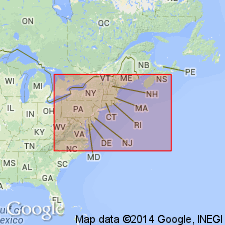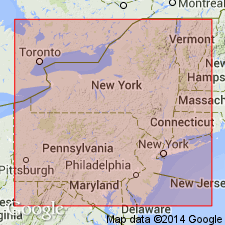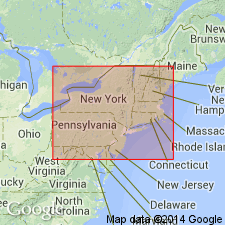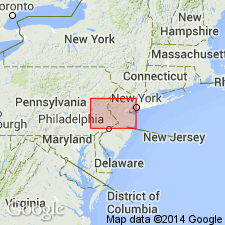
- Usage in publication:
-
- Boonton beds
- Modifications:
-
- Overview
- Dominant lithology:
-
- Shale
- AAPG geologic province:
-
- Newark basin
- Piedmont-Blue Ridge province
Summary:
The Boonton beds at Boonton, NJ, first described by J. H. Smith in 1900, are 1,200 ft (360 m) above the Third Watchung Basalt in the upper Brunswick Formation. Fossil fish occur in a 3 ft (1 m) thick bed of flaggy to fissile, light gray, microlaminated calcareous shale. The fish horizon was buried during construction of the dam for the Jersey City Reservoir.
Source: GNU records (USGS DDS-6; Reston GNULEX).

- Usage in publication:
-
- Boonton Formation
- Modifications:
-
- Named
- Dominant lithology:
-
- Sandstone
- Evaporite
- AAPG geologic province:
-
- Piedmont-Blue Ridge province
Summary:
The Boonton beds of Smith (1900), of the Brunswick Formation are here named the Boonton Formation of the Newark Supergroup. The Brunswick is here abandoned. The Boonton consists of red, brown, gray, and black fine to coarse clastics and minor evaporite beds. Overlies Hook Mountain Basalt and is the youngest unit of the Newark. Thickness at type section is 600 ft (180 m). Age is Early Jurassic.
Source: GNU records (USGS DDS-6; Reston GNULEX).

- Usage in publication:
-
- Boonton Formation
- Modifications:
-
- Age modified
- Biostratigraphic dating
- AAPG geologic province:
-
- Newark basin
- Piedmont-Blue Ridge province
Summary:
The age of the Boonton Formation is Sinemurian to Pliensbachian based on pollen, spore, and reptile footprint assemblages.
Source: GNU records (USGS DDS-6; Reston GNULEX).

- Usage in publication:
-
- Boonton Formation*
- Modifications:
-
- Revised
- AAPG geologic province:
-
- Newark basin
- Piedmont-Blue Ridge province
Summary:
The Boonton Formation of Olsen (1980) is adopted and assigned to the revised Brunswick Group in NJ.
Source: GNU records (USGS DDS-6; Reston GNULEX).
For more information, please contact Nancy Stamm, Geologic Names Committee Secretary.
Asterisk (*) indicates published by U.S. Geological Survey authors.
"No current usage" (†) implies that a name has been abandoned or has fallen into disuse. Former usage and, if known, replacement name given in parentheses ( ).
Slash (/) indicates name conflicts with nomenclatural guidelines (CSN, 1933; ACSN, 1961, 1970; NACSN, 1983, 2005, 2021). May be explained within brackets ([ ]).

